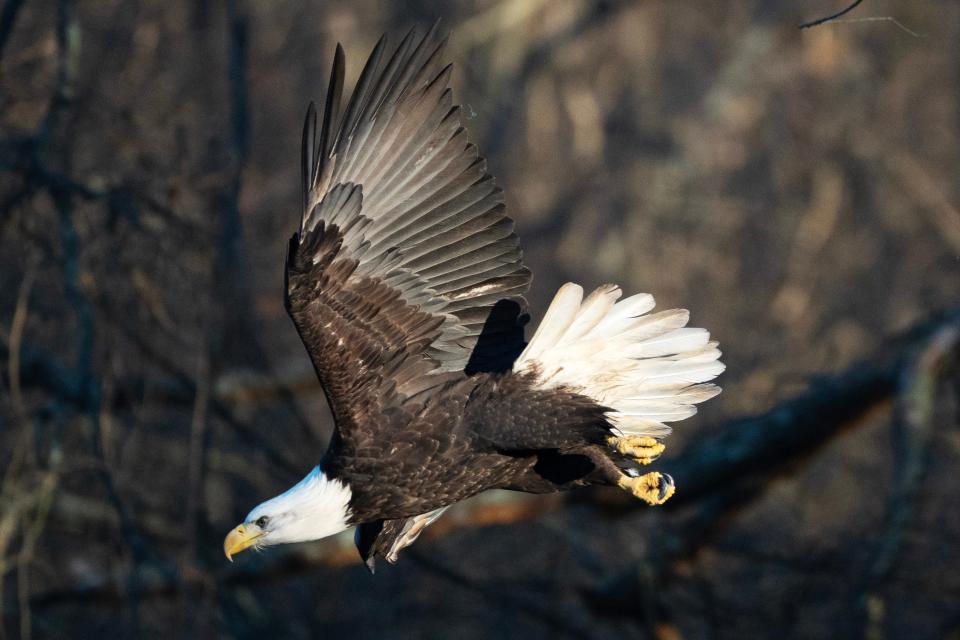The bald and beautiful. Here's why NJ's bald eagle population continues to thrive
After a slight downtick in 2021, New Jersey bald eagles produced a record 335 young last year.
The continued growth in a population that totaled one breeding pair 35 years ago shows little sign of slowing either, according to state officials. In the last decade, the number of breeding pairs has more than doubled and the reproduction rate remains high amid ongoing conservation efforts, a new state report shows.
“The ongoing recovery and growth of New Jersey’s bald eagle population is a remarkable story that gets better with each passing year,” said Dave Golden, the assistant commissioner of the state Fish and Wildlife Service. “Conservation efforts such as protecting sensitive eagle nesting and wintering areas, engaging and educating the public, and tracking eagles’ movements have all contributed to the enormous success of the program.”

In 2022, state officials and volunteers monitored 267 territorial pairs of bald eagles throughout New Jersey. Of those, 250 were active breeding pairs, an increase of 28 from 2021, according to the 2022 New Jersey Bald Eagle Project Report developed by the state Fish and Wildlife Service and the Conserve Wildlife Foundation of New Jersey.
Combined, 236 closely studied pairs reared 1.42 young per nest, well above the range of 0.9 to 1.1 needed for population maintenance. Two came from a new breeding pair in Denville. Another came from a new pair in Edgewater. Three came from a known pair at a new nest location in Boonton.
Story continues below photo gallery.
The Boonton nest was among two dozen new nests found last year as part of the long-running New Jersey Bald Eagle Project. Designed to monitor the population, protect nesting sites and educate landowners, the project started when the number of bald eagles in New Jersey could be counted on one hand.
While bald eagles were seen as a nuisance by early settlers due to concerns over predation on farm and game animals and greatly impacted by forest clearing and water pollution, state experts have estimated anywhere from 10 to 20 pairs held out in far-flung nests into the 1950s.
Then, the eagles' circumstances became considerably worse. Heavy use of the pesticide DDT prior to its 1972 ban contaminated fish and led to eagles laying unviable, thin-shelled eggs. A dramatic population decline ensued.
Throughout the 1970s and during most of the 1980s, New Jersey had one active bald eagle nest. Human intervention eventually helped that pair successfully breed, and a repopulation program followed using juvenile birds sourced from Canada. By 1990, there were four nests with breeding activity. By 2000, there were 23. In 2010, there were 82. Now, there are 250.

"What we're seeing now is a rebounding of the population thanks to the ban of DDT, and also thanks to widespread reforestation and improved water quality," said Michael Allen, an ornithology professor at Rutgers University.
More active nests are likely to pile on in the years ahead, Allen said. How many more, no one is really sure, he added. Though, given trends, Allen said the population growth in New Jersey appears to be slowing. If things continue on a linear tract, he said the growth could cease in about 15 years with a population of about 400 breeding pairs. He stressed that remains a rough calculation prone to variables, including the proven adaptability of the species.
Bald eagles are often shown nesting in tall trees by rivers and eating fish, but have been increasingly known to raise young in increasingly developed areas and scavenge a variety of food.
About half the state's bald eagle nests are either in western Cape May County or the Delaware Bay area of Cumberland and Salem counties, according to state officials. Bald eagles are nonetheless thriving around the lakes, rivers and reservoirs of Central and North Jersey. That includes nests near Monksville Reservoir in West Milford, Lake Mohawk in Sparta and Mount Hope Pond in Rockaway.
New Jersey's bald eagles typically start their nest-building ritual in December or early January. A new pair of young adults can often spend a year tending a nest, as most eagles do not reproduce until four or five years of age. Still, most pairs breed to produce one to three eggs between mid-January and early March. About a month later, the chicks hatch. Generally, the adults use the same nest from year to year and mate as long as they both live. Their nests can grow massive. Some have been 10 feet across and weighed more than a ton.
The USS Ling submarine, mired in Hackensack muck, has a strange history — and murky future
State officials reported seeing 29 new eagle pairs in 2022. Of them, 14 were in the south. Ten were in Central Jersey and five were in the north.
Alternatively, state officials documented 41 bald eagles that were found dead in 2022. Ten were struck by vehicles. Another eight were electrocuted, likely after contacting powerlines. One eagle found at the Salem County Landfill died from poisoning. Another died from eagle-to-eagle combat. Yet another died from possible lead poisoning, a human-related problem typically linked to fishing tackle or firearm ammunition.
Are you ready to evacuate in case of a chemical disaster? Add these to your emergency kit
Though bald eagles were removed from the federal list of endangered species in 2007, the species retains a protected, endangered status in New Jersey during the breeding season. Outside of breeding season, bald eagles are considered state-threatened, records show. The birds are also protected by the Bald and Golden Eagle Protection Act, the Migratory Bird Treaty Act and the Lacey Act.
For more information about the New Jersey Bald Eagle Project, visit the Conserve Wildlife Foundation of New Jersey’s website at conservewildlifenj.org and the DEP’s website dep.nj.gov.
This article originally appeared on NorthJersey.com: NJ bald eagle population keeps growing. Here's why
